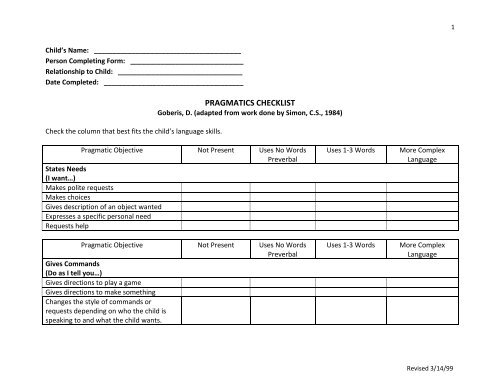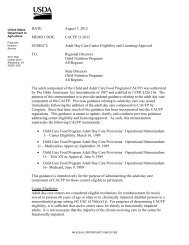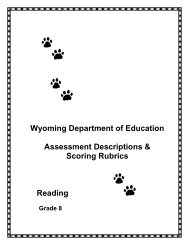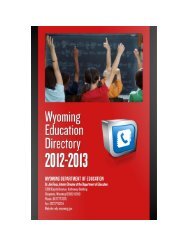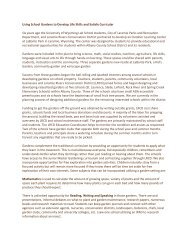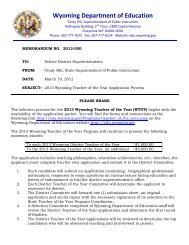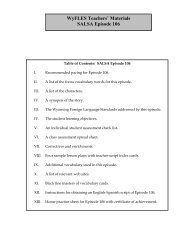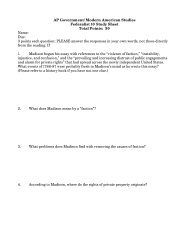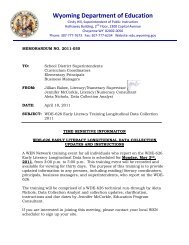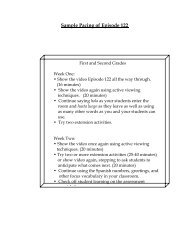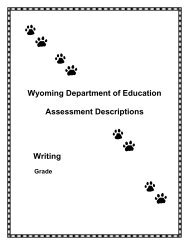PRAGMATICS CHECKLIST
PRAGMATICS CHECKLIST
PRAGMATICS CHECKLIST
Create successful ePaper yourself
Turn your PDF publications into a flip-book with our unique Google optimized e-Paper software.
Child’s Name: _______________________________________<br />
Person Completing Form: ______________________________<br />
Relationship to Child: _________________________________<br />
Date Completed: _____________________________________<br />
Check the column that best fits the child’s language skills.<br />
<strong>PRAGMATICS</strong> <strong>CHECKLIST</strong><br />
Goberis, D. (adapted from work done by Simon, C.S., 1984)<br />
Pragmatic Objective<br />
States Needs<br />
(I want…)<br />
Makes polite requests<br />
Makes choices<br />
Gives description of an object wanted<br />
Expresses a specific personal need<br />
Requests help<br />
Not Present Uses No Words<br />
Preverbal<br />
Pragmatic Objective<br />
Gives Commands<br />
(Do as I tell you…)<br />
Gives directions to play a game<br />
Gives directions to make something<br />
Changes the style of commands or<br />
requests depending on who the child is<br />
speaking to and what the child wants.<br />
Not Present Uses No Words<br />
Preverbal<br />
Uses 1-3 Words More Complex<br />
Language<br />
Uses 1-3 Words More Complex<br />
Language<br />
1<br />
Revised 3/14/99
Pragmatic Objective Not Present Uses No Words<br />
Preverbal<br />
Personal<br />
(Expresses Feelings…)<br />
Identifies feelings (I’m happy.)<br />
Explains feelings (I’m happy because it’s<br />
my birthday.)<br />
Provides excuses or reasons<br />
Offers an opinion with support<br />
Complains<br />
Blames others<br />
Provides pertinent information on request<br />
(2 or 3 of the following: name, address,<br />
phone number, birth date)<br />
Pragmatic Objective<br />
Interactional<br />
(Me and You…)<br />
Interact with others in a polite manner<br />
Uses appropriate social rules such as<br />
greetings, farewells, thank you, getting<br />
attention<br />
Attends to the speaker<br />
Revises/repairs an incomplete message<br />
Initiates a topic of conversation (doesn’t<br />
just start talking in the middle of a topic)<br />
Maintains a conversation (able to keep it<br />
going)<br />
Ends a conversation (doesn’t just walk<br />
away)<br />
Not Present Uses No Words<br />
Preverbal<br />
Uses 1-3 Words More Complex<br />
Language<br />
Uses 1-3 Words More Complex<br />
Language<br />
2<br />
Revised 3/14/99
Interjects appropriately into an already<br />
established conversation with others<br />
Makes apologies or gives explanations of<br />
behavior<br />
Requests clarification<br />
States a problem<br />
Criticizes others<br />
Disagrees with others<br />
Compliments others<br />
Makes promises<br />
Pragmatic Objective<br />
Wants Explanations<br />
(Tell me Why…)<br />
Asks questions to get more information<br />
Ask questions to systematically gather<br />
information as in “Twenty Questions”)<br />
Asks questions because of curiosity<br />
Asks questions to problem solve<br />
(What should I do…?, How do I know…?)<br />
Asks questions to make predictions<br />
(What will happen if…?)<br />
Not Present Uses No Words<br />
Preverbal<br />
Pragmatic Objective<br />
Shares Knowledge and Imaginations<br />
(I’ve got something to tell you…)<br />
Role plays as/with different characters<br />
Role plays with props (banana as a phone)<br />
Provides a description of a situation which<br />
Not Present Uses No Words<br />
Preverbal<br />
Uses 1-3 Words More Complex<br />
Language<br />
Uses 1-3 Words More Complex<br />
Language<br />
3<br />
Revised 3/14/99
describes the main events<br />
Correctly re-tells a story which has been<br />
told to them<br />
Relates the content of a 4-6 frame picture<br />
story using correct events for each frame<br />
Creates an original story with a beginning,<br />
several logical events, and an end<br />
Explains the relationship between two<br />
objects, actions or situations<br />
Compares and contrasts qualities of two<br />
objects, actions or situations<br />
Tells a lie<br />
Expresses humor/sarcasm<br />
4<br />
Revised 3/14/99


